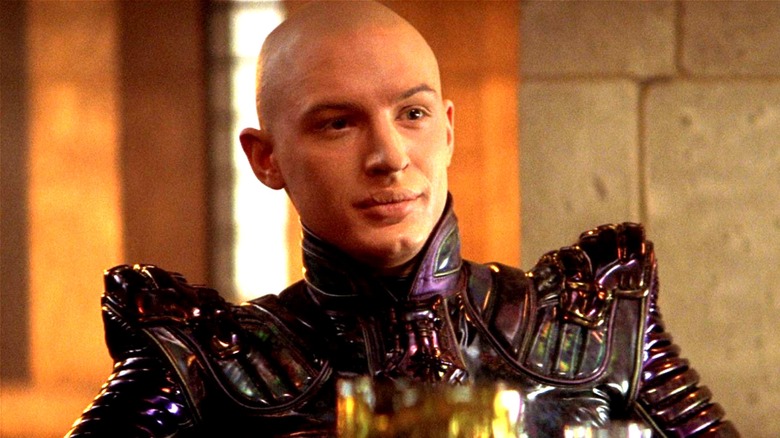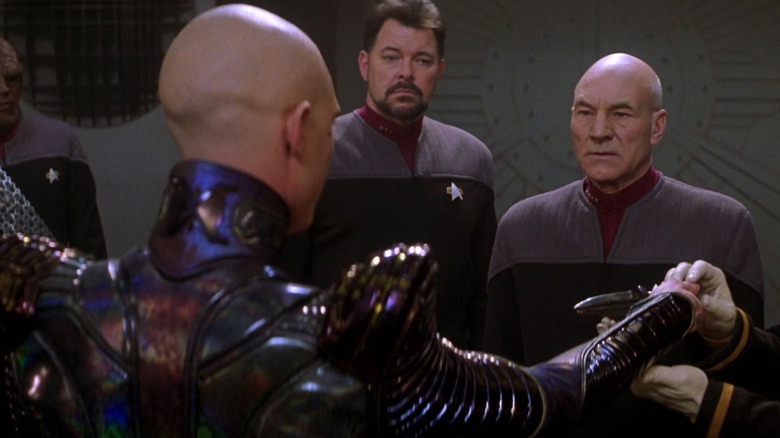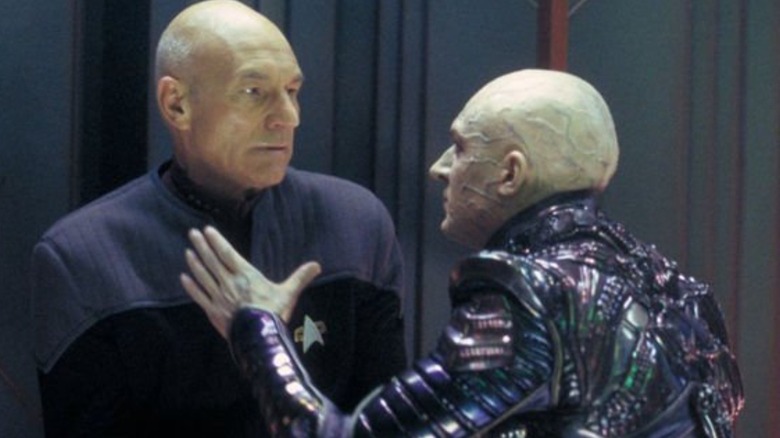Patrick Stewart Avoided Tom Hardy On The Star Trek: Nemesis Set For A Good Reason
Although Tom Hardy is a household name these days, he was still relatively unknown when he appeared as a younger and naughtier version of Picard in "Star Trek: Nemesis." With prosthetics and makeup to help him look more like his older counterpart, fans could be forgiven for forgetting Hardy was in "Star Trek: Nemesis altogether.
As Shinzon, the Romulan clone of Picard, Hardy had his work cut out for him. Not only did he have to believably pass as a younger version of Patrick Stewart's esteemed Starfleet captain, but he also had to bring the weight of a villain to the role without coming across as campy or watered down. Although "Nemesis" was by no means the strongest "Next Generation" Trek film, the interactions between Hardy and Picard's characters were one of its stronger points. And according to Stewart, that may have been aided by their off-screen chemistry — or rather, the lack thereof.
According to Patrick Stewart, Hardy was something of a ghost while on set. Rather than work to build a connection, Stewart chose to let the younger actor keep his distance, as explained in "The Fifty-Year Mission: The Next 25 Years: From The Next Generation to J. J. Abrams: The Complete, Uncensored, and Unauthorized Oral History of Star Trek" by Mark A. Altman and Edward Gross. In Stewart's own words, "I wanted our life to be a life in front of the camera, apart from the small talk of sitting around waiting to work, of which, even then, there was very little. If there was an edge in the relationship, I wanted it to be visible when the camera rolled."
Tom Hardy found the role intimidating
Plenty of actors would be understandably intimidated when playing their first major role without having to worry about acting in Patrick Stewart's shadow. Tom Hardy would later tell Total Film Magazine, "I was terrified. Every day on that set, I was terrified – which worked for the character anyway." Hardy added, "You can't hide that, the camera will pick it up. I was genuinely out of my depth." Expanding on that sentiment in a BBC interview, the actor emphasized that this had been his first experience working for an established franchise, not to mention his first time working in Hollywood, adding, "So I was terrified of failure."
His nervousness was hard to hide, as Stewart observed in "The Fifty-Year Mission." "It's not just that it was a large role, but he had to carry the weight of the antagonist in a 'Star Trek' movie," Steward said. "Major scenes of dialogue, complex emotions."
Director Stuart Baird felt this pressure worked in service of the film, noting that Hardy was intimidated by Stewart due to his respect for the actor. "That played on the vulnerability side of it," Baird said.
Patrick Stewart gave Tom Hardy his space
Whether he was too focused on nailing the part, too intimidated by the pressure of interacting with "Star Trek: The Next Generation" cast, or just overstimulated by the experience only Tom Hardy knows. But whatever the reason, Hardy's overall discomfort led to some awkward — and minimal — interactions with the rest of the cast. According to Patrick Stewart in "Making it So: A Memoir," Tom Hardy mostly kept to himself while on set. When he wasn't in front of the camera, Stewart said the young actor was hanging out in his trailer. His social interactions were so sparse that Hardy didn't even greet the other actors, let alone try to connect with them socially.
But that's not to say Hardy was rude. "He was by no means hostile," Stewart wrote. "It was just challenging to establish any rapport with him." Ever the consummate professional, Stewart, like Baird, understood that this could work to the film's advantage. As Stewart expressed in "The Fifty-Year Mission," the two Picards never socialized while on set, but that was fine by him, noting, "I felt that keeping some distance between us was proper."
This naturally added to the tension that played out between the pair on screen. Realizing any small talk should be secondary to producing excellent Shinzon-Picard interactions, Stewart explained, "If there was an edge in the relationship, I wanted it to be visible when the camera rolled. To that extent, I think both of us were cautious of the other one." And the minimal interactions seemed to work in their favor. Not only did he end up excelling in his portrayal of Shinzon, but Tom Hardy would go on to prove Patrick Stewart's awkward first impression of him wrong by becoming a huge star.


